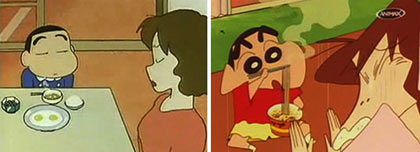

Stylistic Evolution in Crayon Shin-chan

My favorite anime critic, Ben Ettinger, recently wrote a piece about the long-running Japanese animated series CRAYON SHIN-CHAN and how since its debut in 1992, the animators’ styles have evolved and become more distinct and personal. Initially, the show remained faithful to the comic that it was based on, which from what I’ve seen is rather poorly drawn, but within a couple seasons the animators were pushing the look of the show into a more experimental (and even abstract) direction. Check out the revealing stills above – left is from a 1992 episode, right is from 1996. (Ben’s article also includes links to video clips.)
What strikes me as fascinating about this stylistic evolution is that it’s the complete opposite of the tendencies of US series. Here, the drawing in shows – most shows, at least – tightens up with every passing season, exemplified most clearly (and sadly) in America’s longest running animated series THE SIMPSONS, which hasn’t had an original character expression or bit of movement in well over a decade.
SIMPSONS producers, quite unbelievably, pride themselves on putting out a show that doesn’t exhibit stylistic evolution – and they certainly wouldn’t stand for anything that showed personal creativity or the sign of an individual’s hand in the production. Imagine a record label that asks a musician to compose one song and then replay that song for the rest of his career. No self-respecting musician would ever agee. But on the SIMPSONS, machine-like repetition of style is the order of the day. If a layout artist on the SIMPSONS draws ‘off-model,’ that’s viewed without question as an error, never as a creative choice on the part of the artist. It wasn’t always like that. THE SIMPSONS allowed artists some extent of creative feedom for quite a few seasons, especially during its earliest Klasky Csupo years, and also in some of the subsequent Film Roman seasons. By season six or seven, however, the producers had clamped down and decided that the show was going to exclusively be a platform for smug writing and dialogue, not for anything resembling art or animation. It’s refreshing to find that in Japan, certain animated shows still allow for artists to be a creative partner in the production of the series. Animation producers in the US could stand to learn from this and recognize that letting artists grow with a show can only be something positive.
